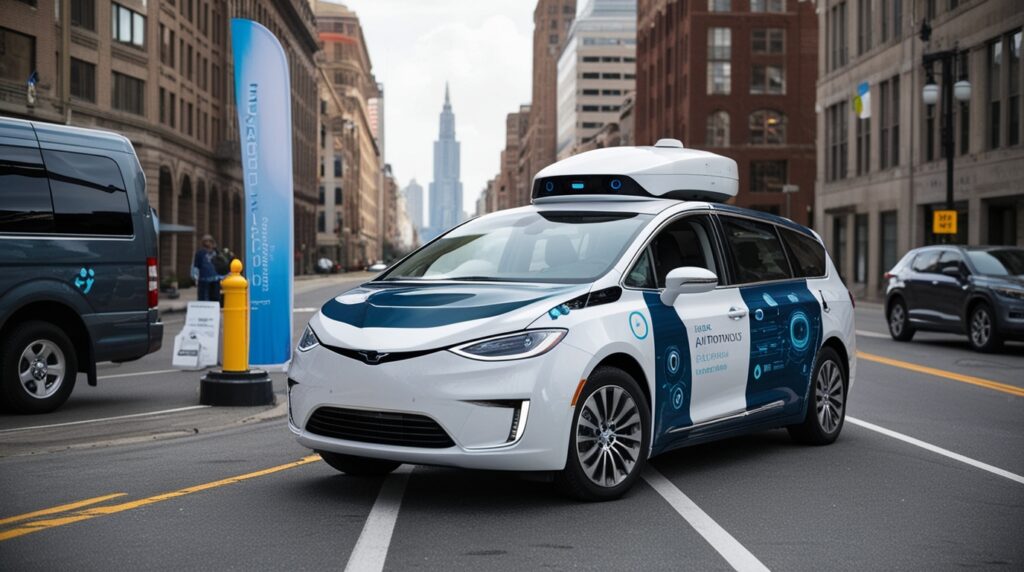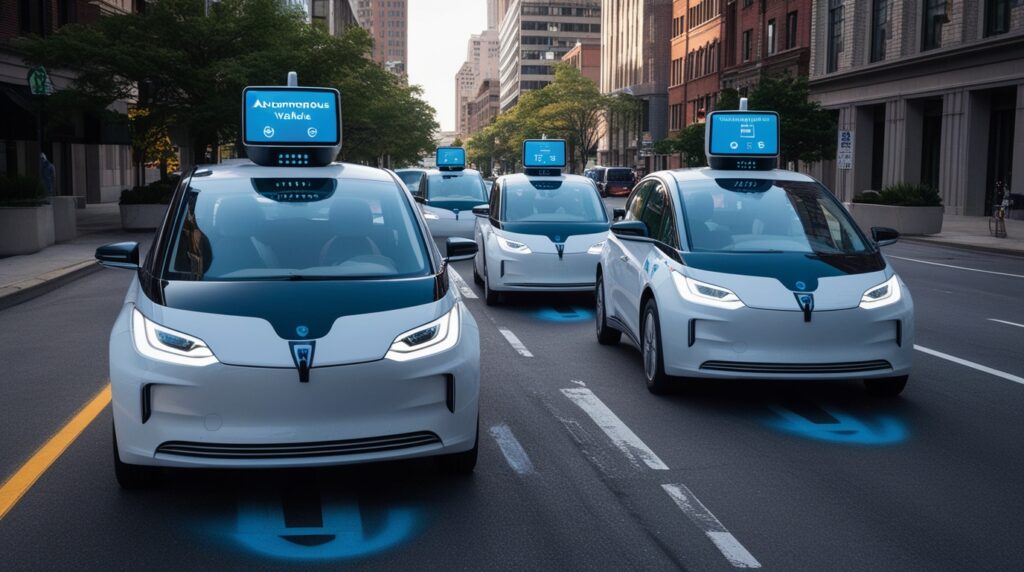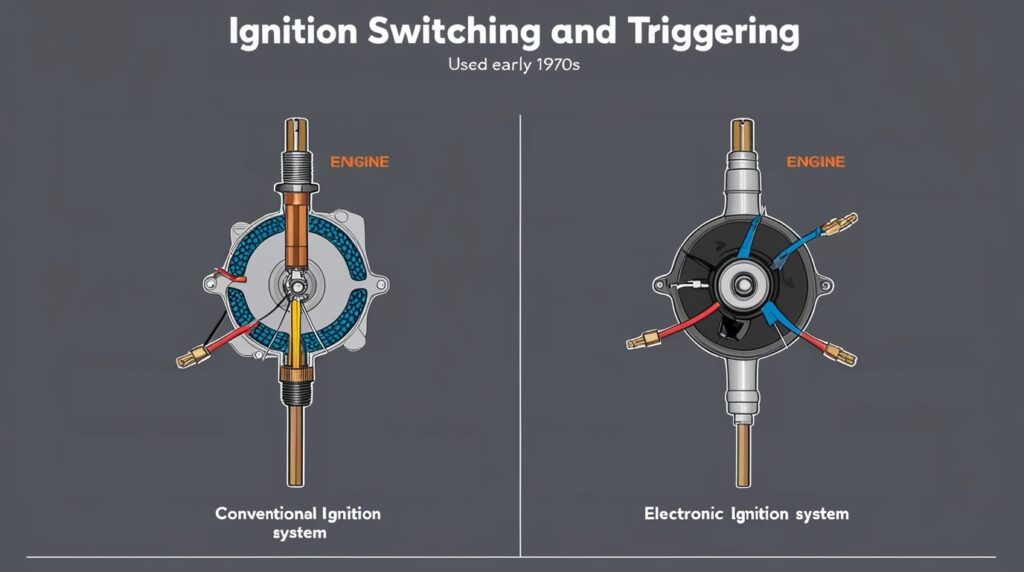
Introduction
Autonomous vehicles (AVs) are an emerging technology that promises to revolutionize transportation by enabling vehicles to operate without human intervention. These vehicles leverage advanced technologies such as artificial intelligence, machine learning, and sensor systems to navigate and make driving decisions, offering potential benefits like reduced traffic accidents, lower emissions, and enhanced mobility options for underserved populations.
The evolution of Autonomous Vehicles reflects broader trends in urban mobility, where integrated, technology-driven solutions are being developed to address challenges such as congestion and environmental sustainability. The notion of AVs dates back to the early 20th century but gained significant momentum in the 21st century due to advancements in automation technology and an increased focus on safety and regulatory frameworks.
Notably, legislation like the Autonomous Vehicle START Act has aimed to foster innovation by easing regulatory constraints, highlighting the importance of collaboration among industry stakeholders, governments, and regulatory bodies. Despite their potential, the rollout of AVs has been met with challenges including technical hurdles, ethical considerations, and public acceptance concerns, raising critical debates about the societal implications of this technology.
As Autonomous Vehicles become more integrated into transportation systems, they are seen as vital to developing smart cities and sustainable urban environments. This shift is expected to promote shared mobility solutions and alter traditional vehicle ownership models, potentially leading to reduced congestion and enhanced accessibility for all demographics. However, the success of Autonomous Vehicle deployment hinges on addressing regulatory inconsistencies, ensuring equitable access, and navigating the complex ethical landscape associated with autonomous decision-making in critical situations.
The discourse surrounding Autonomous Vehicles is multifaceted, encompassing environmental, economic, and safety dimensions. Research indicates that AVs could contribute to significant reductions in traffic-related fatalities and environmental impact, while also creating economic opportunities through increased efficiency in urban transport systems. As the technology continues to evolve, so too does the dialogue regarding the implications of autonomous mobility solutions, ensuring that discussions remain relevant as we approach an era where Autonomous Vehicles may become commonplace on our roads.
History
The concept of autonomous vehicles (AVs) dates back to the early 20th century, with initial experiments primarily focused on automation technology. The first notable instance was in the 1950s, when Frank Rowsome Jr. wrote about the Imperial’s auto-pilot car in Popular Science, which highlighted early attempts at creating self-driving technology. Over the decades, these technologies evolved, laying the groundwork for more sophisticated automated systems.
By the 1970s, vehicle automation saw substantial developments, as manufacturers like Lincoln began integrating advanced features into their models. The 1970 Lincoln Continental and Continental Mark III brochure described innovations that would eventually contribute to the foundations of Autonomous Vehicle technology. Despite these early advancements, significant regulatory and technological barriers hindered widespread adoption. In the early 21st century, the landscape began to change as emerging technologies and a renewed focus on safety catalyzed advancements in autonomous systems.
By 2014, research highlighted the necessity of establishing comprehensive regulatory frameworks to facilitate the introduction of Autonomous Vehicles into public infrastructure. It became increasingly clear that collaboration among industry stakeholders, governmental bodies, and standards agencies was crucial to ensure safety and performance criteria for Autonomous Vehicles. As states began to pass laws permitting the operation of autonomous vehicles, the regulatory environment evolved. In particular, one of the pivotal pieces of legislation was the AV START Act, which sought to ease the regulatory burden on AV technology and promote innovation.
This period marked a significant shift towards recognizing the potential of Autonomous Vehicles to transform urban mobility, as well as the imperative for regulators to adapt to the rapid pace of technological advancement. By the 2020s, the convergence of various trends, such as vehicle electrification and connected vehicle technology, began to influence the deployment of Autonomous Vehicles, with the promise of real-time interaction between vehicles and transport infrastructure.
The integration of autonomous vehicles into existing transport networks underscored the importance of a comprehensive approach to mobility that balances high-tech and low-tech solutions to ensure sustainable growth. As cities grappled with the implications of these changes, the dialogue around regulatory frameworks and public acceptance of Autonomous Vehicle technology continued to evolve, setting the stage for the future of mobility solutions.

Technology
Intelligent Transportation Systems (ITS)
Intelligent Transportation Systems (ITS) utilize advanced technologies to improve the management and efficiency of road transport, involving infrastructure, vehicles, and users. ITS encompasses both hardware and software components, where hardware includes IoT devices, sensors, detection cameras, and traffic lights, while software consists of traffic management packages, environmental traffic management, and data analytics. These systems aim to enhance urban mobility by streamlining traffic flow and providing real-time data to improve decision-making.
Urban Mobility Innovations
Innovative urban mobility systems are being developed globally to address the challenges of congestion, safety, and environmental impact. For example, Singapore’s SMART-FM initiative employs technological and institutional innovations to enhance accessibility and equity in transportation while boosting environmental performance. Furthermore, cities like Amsterdam are implementing mobility hubs that integrate various transport modes, including shared mobility options, in a bid to reduce reliance on private cars.
Vehicle-to-Infrastructure (V2I) Communication
As autonomous vehicles (AVs) continue to evolve, there is significant debate regarding the investment in vehicle-to-infrastructure (V2I) systems. These systems consist of sensors embedded in roads or traffic signs that provide critical navigation data to AVs. The choice between dedicated short-range communications (DSRC) and cellular vehicle-to-everything (C-V2X) technologies remains contentious among industry stakeholders. Nevertheless, the rapid growth of the V2I ecosystem is essential for the seamless operation of AVs within urban environments.
Autonomous Vehicle Technologies
The technology underpinning autonomous vehicles primarily consists of a perceptual system and a control system. The perceptual system uses data from various sensors, such as cameras and LiDAR, to determine the vehicle’s position and detect surrounding objects. Machine learning algorithms process this data to navigate and make driving decisions safely. Each sensor type has its advantages and limitations in providing accurate environmental perception, making their integration critical for the functionality of Autonomous Vehicles.
Infrastructure and Support Facilities
As cities transition to support autonomous fleets, the need for dedicated infrastructure becomes apparent. This includes support facilities for servicing and charging AVs. Planning for these facilities should be done thoughtfully to minimize disruption to urban life, and they can often repurpose existing structures, such as underutilized parking garages. Effective infrastructure investments are vital not only for supporting AV operations but also for enhancing overall road safety and reducing wear and tear on vehicles.
Types of Autonomous Vehicles
Autonomous vehicles (AVs) can be categorized based on their level of automation, as well as their intended use within transportation systems. The Society of Automotive Engineers (SAE) defines six levels of driving automation, ranging from Level 0, where the driver is fully in control, to Level 5, which features full self-driving capabilities without any human intervention. This classification aids in understanding the various capabilities and functionalities of AVs in real-world applications.
Levels of Automation
Level 0: No Driving Automation
At this level, drivers have complete control of the vehicle with minimal electronic assistance. Basic safety features like Electronic Stability Control (ESC) may be present, but they do not constitute automation.
Level 1: Driver Assistance
In this scenario, an automated driving system can perform specific tasks such as steering or accelerating, but human drivers must remain engaged and ready to take control if necessary. Features such as adaptive cruise control are typical examples of Level 1 automation.
Level 2: Partial Automation
Level 2 Autonomous Vehicles can control both steering and acceleration/deceleration under certain conditions, but human drivers must monitor the driving environment at all times. Tesla’s Autopilot and Audi’s Traffic Jam Pilot are examples of systems classified under this level.
Level 3: Conditional Automation
At Level 3, the vehicle can handle all aspects of driving in specific scenarios, such as highway driving, while the driver can disengage from active control. However, the driver must be prepared to intervene when requested by the vehicle.
Level 4: High Automation
Level 4 vehicles can operate autonomously in predefined environments without human intervention, although they may require a human driver in more complex scenarios. An example includes autonomous shuttles that operate within designated urban areas.
Level 5: Full Automation
Vehicles at this level do not require any human input for operation and can handle all driving tasks in all environments. These vehicles are envisioned to eliminate the need for traditional controls such as steering wheels and pedals.
Categories of Autonomous Vehicles
Ride-Hailing Services
Autonomous ride-hailing services, such as robo-taxis, leverage Level 4 and Level 5 technologies to provide on-demand transportation without human drivers. These services aim to reduce congestion and improve efficiency in urban areas by deploying fleets of shared AVs.
Shared Mobility Solutions
The rise of shared autonomous vehicles (SAVs) allows for increased vehicle utilization, which could potentially replace personal vehicle ownership. Research indicates that the mobility needs of cities could be met with significantly fewer vehicles if shared Autonomous Vehicles are integrated into the transportation network.
Delivery Vehicles
Autonomous delivery services are emerging, utilizing Autonomous Vehicle technology to transport goods efficiently. These vehicles are often designed to navigate urban environments and may be equipped with specialized compartments for different types of cargo. As technology continues to advance, the potential applications and types of autonomous vehicles will likely expand, leading to a transformative impact on mobility solutions in urban settings.
Benefits
Autonomous vehicles (AVs) and future mobility solutions present a range of potential benefits that could significantly transform urban transportation and improve the quality of life for individuals and communities.
Environmental Impact
From an environmental perspective, Autonomous Vehicles are expected to contribute to reduced energy use and lower emissions. As the shift towards electromobility continues, electric vehicles (EVs) powered by renewable energy sources will further decrease the carbon footprint of urban transport. AVs encourage sustainable transport choices, potentially mitigating issues such as traffic congestion and air pollution, which are significant challenges faced by modern cities.
Safety and Public Health
One of the most significant advantages of Autonomous Vehicles is their potential to enhance safety on the roads. According to studies, approximately 94% of traffic accidents are caused by human errors, suggesting that the implementation of AV technology could drastically reduce the incidence of accidents and save thousands of lives annually. Additionally, improved safety could lead to a reduction in healthcare costs associated with road traffic injuries, thus enhancing public health outcomes.
Economic Benefits
The economic implications of integrating Autonomous Vehicles into urban mobility systems are profound. Research estimates that seamless mobility could yield social benefits amounting to up to $2.5 billion per year in an average city by 2030, potentially boosting its GDP by as much as 3.9%. This increase in economic activity is largely attributed to reduced congestion, which, along with better access to job markets and services, can enhance productivity and quality of life for residents.
Accessibility and Mobility
The integration of Autonomous Vehicles can improve accessibility, particularly for vulnerable populations such as the elderly and disabled, thereby enhancing their mobility and quality of life. Mobility as a Service (MaaS) models, which leverage shared AVs, can provide these groups with improved access to essential services, reducing social isolation and fostering community inclusion.
Increased Adoption of Shared Mobility
The rise of Autonomous Vehicles is also expected to promote greater adoption of car-sharing and other shared mobility solutions. These models can lead to reduced total car ownership, thereby decreasing the overall number of vehicles on the road, which can alleviate congestion and further enhance the urban environment.
Challenges
The development and deployment of autonomous vehicles (AVs) face numerous challenges across various domains, including technical, social, and regulatory factors.
Regulatory Challenges
Traditionally, the regulation of automobiles in the United States has been a shared responsibility between federal and state governments, with the federal government primarily overseeing the physical components of vehicles and states managing licensing. This division has led to significant state influence over the AV industry, particularly concerning driverless capabilities, which align more closely with licensing regulations.
At present, 40 states have enacted legislation or issued executive orders related to Autonomous Vehicles, indicating a growing regulatory landscape that varies widely across jurisdictions. For instance, Massachusetts outlines specific operational regulations and safety standards for motor vehicles in its General Laws, including provisions that could affect the deployment of Autonomous Vehicles on its roadways.
Technical Challenges
The deployment of Autonomous Vehicles involves intricate technical challenges that must be addressed to ensure safety and reliability. These challenges include validation and testing of the vehicles’ hardware and software, which are essential to meet the rigorous safety requirements demanded by stakeholders.
The process of validating Autonomous Vehicles is not only time-consuming but also varies significantly based on the complexity of the vehicle model. Furthermore, AVs must operate effectively in unpredictable situations, necessitating advanced software systems that can adapt to various driving scenarios while ensuring fail-safety.
Ethical and Moral Considerations
As Autonomous Vehicles are designed to operate independently, they encounter ethical dilemmas that require effective decision-making frameworks. The ethical decision-making process in autonomous vehicles is complex, involving considerations of moral values and emotional responses, which can significantly influence the behavior of the vehicle in critical situations. Researchers have begun to explore models that integrate ethical considerations into AV algorithms, recognizing the need for a holistic understanding of how ethical decision-making occurs within this context.
Social and Equity Issues
The challenge of urban mobility encompasses a diverse range of stakeholders, including governments, municipalities, and service providers. Each city presents unique challenges, and solutions often require customization to be effective. Moreover, ensuring equity in transportation systems is crucial; the design must provide equal access to all populations, regardless of socioeconomic status, which adds an additional layer of complexity to the integration of Autonomous Vehicles into existing transportation networks.
Future Trends
The Evolution of Urban Mobility
The ongoing transformation in urban mobility is significantly influenced by advancements in autonomous vehicles (AVs) and electric vehicles (EVs). As cities evolve, the integration of these technologies is anticipated to alter vehicle ownership models, introduce novel usage paradigms, and necessitate new infrastructure tailored to the unique characteristics of EVs and AVs. Shared use mobility (SUM) is a critical component of this shift, challenging traditional transport modes like private cars and taxis, and promoting a more collaborative approach to urban transport.
Technological Integration and Challenges
As of 2023, the autonomous-vehicle industry has experienced both remarkable progress and considerable setbacks. Major companies have successfully scaled their operations, while others have exited the market. The McKinsey Center for Future Mobility highlights that expectations regarding the development timelines for AVs are shifting, alongside increasing investments in the sector. While the potential for Autonomous Vehicles to enhance urban mobility is significant, it is accompanied by challenges such as potential job displacement in driving and mechanical roles, as well as the need to ensure equitable access to mobility services.
The Seamless Mobility Model
In densely populated, high-income cities, the transition to a Seamless Mobility model appears promising. This model envisions a flexible transport system that allows residents to quickly switch between different modes of transportation, including AVs and shared mobility options. Urban centers like Houston, the Ruhr area of Germany, and Sydney are identified as potential leaders in adopting this model due to their technological openness and capacity for effective public project implementation.
Environmental and Economic Implications
The benefits of these mobility trends could be substantial. High-income, low-density metropolitan areas are projected to realize significant societal benefits, potentially boosting GDP by 0.9% annually by 2030, largely due to improvements in passenger safety and reduced congestion costs. However, it is essential to consider that environmental gains might be limited as increased vehicle miles could offset some of the benefits associated with cleaner technologies. To maximize positive outcomes, city officials must ensure that the integration of AVs and EVs does not exacerbate existing traffic and pollution issues.
Case Studies
Introduction to Case Studies
Case studies are essential for understanding the practical implications of autonomous vehicles (AVs) in various contexts. These studies not only provide insights into the deployment of AV technologies but also highlight the challenges faced during implementation and the societal responses to these innovations.
Regulatory Frameworks
Federal and State Regulations
The regulatory landscape for autonomous vehicles in the United States is multifaceted, with federal, state, and local authorities each playing significant roles. Traditionally, the federal government oversees the regulation of vehicle components, while states manage licensing and operational regulations.
As of recent reports, 40 states have enacted legislation or issued executive orders concerning Autonomous Vehicles, demonstrating a proactive approach to governance in this emerging field. For instance, Massachusetts has specific laws that address registration standards and minimum safety requirements for functional vehicle components.
Local Government Initiatives
Local municipalities are also developing frameworks to oversee Autonomous Vehicle technology, as seen in Boston’s initiative which establishes guidelines for the development and deployment of AVs on city roadways. This approach ensures that Autonomous Vehicle companies must enter into agreements with local governments to operate within the city, thereby fostering collaboration and oversight.
Industry Partnerships
Strategic Collaborations
The autonomous vehicle sector is increasingly characterized by strategic partnerships among technology firms and traditional automakers. A recent study indicated that 96% of industry leaders consider partnerships crucial for advancing Autonomous Vehicle technologies. Collaborations facilitate resource sharing, enhance innovation, and help companies tackle the inherent risks associated with large-scale deployment. For instance, technology companies like Google are partnering with automotive manufacturers such as Tesla and Audi to leverage their respective strengths in software and hardware development.
Public Perception and Trust
Public Attitudes
Public perception plays a pivotal role in the acceptance and deployment of Autonomous Vehicle technologies. A study utilizing machine learning techniques to analyze Twitter data revealed that the majority of tweets about Autonomous Vehicles were positive, though concerns regarding safety and privacy were prevalent. Addressing these concerns is vital for fostering public trust, and researchers are exploring methods like Explainable Artificial Intelligence (XAI) to improve understanding of AV decision-making processes.
Simulation and Testing
Realism in Testing Scenarios
In testing autonomous systems, construct validity is critical to ensure that the simulations accurately represent real-world conditions. To mitigate threats related to simulation realism, researchers utilized BeamNG as a soft-body simulation environment. This approach aims to improve safety-critical scenario testing by closely mimicking real driving conditions. Additionally, a stratified random sampling method was employed to evaluate the execution times of test cases, confirming that variability was negligible”.



